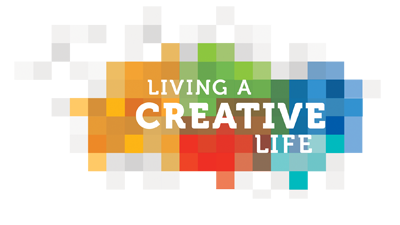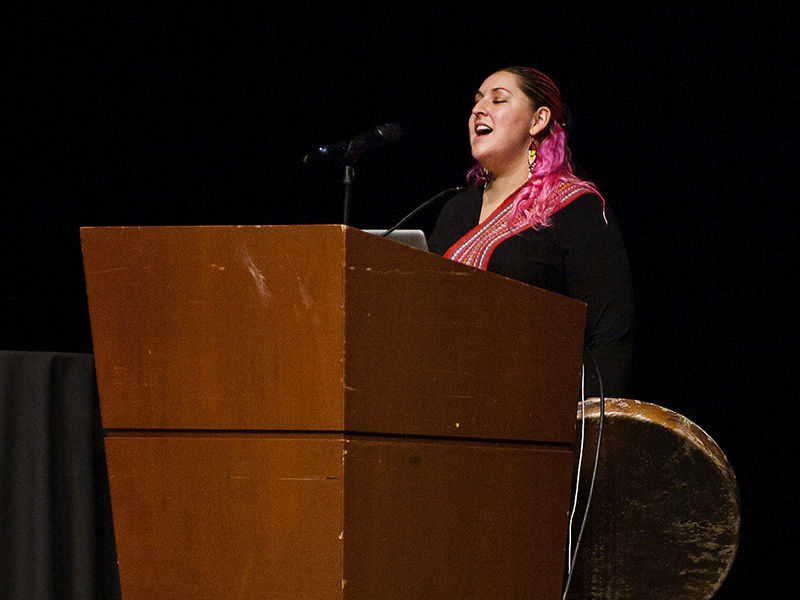Chantal Chagnon
Traditional ways of knowing help create beauty in everything she does
Chantal Chagnon has always lived a creative life, both inside her home—and out in her community.
The Calgary-based Cree Ojibwe Métis singer, drummer, artist, and activist even has it in the name of her business—Cree8, a cultural education centre and art studio that celebrates Indigenous culture.
At home, Chagnon’s creative life centres around two special-needs sons.
“Both my boys are on the Aspergers spectrum, but different ends of the spectrum,” she says. “They look at the world through a different lens so it allows you to really observe the world though the different lenses as well. You have to be very creative as a parent when you have special needs kids.”
In the Calgary community, Chagnon is a force of nature, whether wearing her activist’s hat—she organizes the yearly Valentine’s Day march for missing and murdered Indigenous women every February, along with the being part of the organizing council for the Sisters in Spirit march every October 4—leading workshops, or traveling across Calgary to teach her traditional ways to schoolchildren, using a big duffel bag filled with exquisite, handmade drums and other instruments.
“You see my traditional ways of knowing,” she says, “to help create beauty around me—whether that’s teaching different songs, or in how I make my drums and my drumsticks and am able to share them, which is a really incredible way to connect my past as well as my current applicable present to our day and age.”
It turns out that the creation of each instrument is as much an act of a very creative life as the music Chagnon performs on them—making a recent news story that much more painful.
“Every time I make a drum, it’s a new spirit,” she says.
That spirit-making resonated even more loudly on May 8, when news broke that Chagnon’s van had been broken into outside her Dalhousie home and the offices of Cree8.
The van wasn’t stolen, but a duffel bag containing around 30 drums was, along with a ceremonial knife.
The thieves also left drums inside the van that were more visible than the ones in the duffel bag, leading Chagnon to speculate that they may have thought the duffel bag contained something with greater resale value—like hockey gear—which raised her hopes they would be returned.
“If they can find a place to just drop them off or even just leave an anonymous tip of where they’re located, just to bring them home, that would be amazing,” she said in a CBC radio interview the day after the incident.
While the police searched for her missing drums, Chagnon continued to search for creative ways to keep the public eye on missing and murdered Indigenous women—by sharing the stories of those who can no longer speak to the media covering both the commission and the public protests designed to generate greater public awareness of a marginalized group of murder victims.
“Statistics you can’t relate to,” she says, “but somebody’s story is about their daughter, or their mom or about their auntie—somebody who’s been missing.
“Those stories are what is going to change our hearts and our minds about each other, not statistics.”
What extends Chagnon’s creative life into another dimension entirely is that she also happens to be a science nerd.
“I love science and the universe,” she says. “How sometimes, our traditional teachings have direct relation to the movement of the planets—for example—we have the medicine wheel, which is about the seasons. It’s about the times of the day, it’s about the times of our life—and whenever there are articles that come out essentially proving what we’ve believed for thousands of years, boom! I get really excited.”
Shortly after the van break-in, which received extensive media coverage, Chagnon set out to build more drums, to replace the stolen ones.
Each drum, she said, takes up to around 10 hours to create—not much, really, seeing as Chagnon believes it was those drums that turned her life around several years ago, when she was badly injured after being hit by a truck after the vehicle she was in had stalled and she got out to push.
Chagnon was unable to walk for a month, and has had three hip reconstructions, as well as waiting for another hip surgery, shoulder surgery, and possibly more—all while trying to care for two special needs boys.
“It’s been an adventure,” she says.
What’s remarkable is that Chagnon took a piece of terrible luck and used it as a catalyst to propel her life forward, rather than letting it sink her spirit.
When she was hit, she was in the process of opening up a day home, looking after kids. The accident caused her life to change course.
“Even though it sucked, getting hit by a truck and going through all those surgeries, it put me on the path that I’m on now—and so I honour that journey,” she says. “It led me to the path of activism because if it wasn’t for that accident, I would have been raising other people’s children in a day home, and not been out in the political spectrum or in the schools, performing and presenting.”
Turns out getting hit by a truck was good for Chagnon’s love life, too.
“I wouldn’t have met my partner [they are an anthropologist who was researching social activism] if not for the accident, because I wouldn’t have been the activist I am now,” she says, “and I wouldn’t have been the artist that I am now—it eliminated that fear that kept holding me back.”
None of which the drum thieves knew when they heisted what looked to be a duffel bag filled with shoulder pads, elbow pads, helmets and hockey pants.
While that incident was a disruption, and upsetting, it probably doesn’t amount to a whole lot when looked at through the long lens of seven generations—which is how Chagnon views everything.
“As an Ojibwe woman, we think seven generations behind,” she says. “Which is what my ancestors do—reflecting on what sacrifices they made. What ground did they lay—and what did they do to bring me to this moment, to create the life I’m in now, when I’m not honouring them? What have they given up to bring me here? What do they continue to teach, to bring me here?
“We think seven generations ahead too,” she adds. “ because we have to think that we’re part of this bigger universal picture.”
As it turns out, a few days after the drums go missing, they are discovered, unharmed, a few blocks away.
In a Facebook posting announcing the happy news, Chagnon wrote, “They’re home!”
Why it matters to live a creative life is pretty literally clear to Chagnon.
“It’s healing,” she says. “It’s our way of connecting and understanding the world around us. And our way of really coping in a more positive and really thoughtful way—and why not?
“People are really hesitant to call themselves creative,” she adds, “but everyone is creative in their own way.”
That includes Chagnon.
“I had a fear of calling myself an artist,” she says. “Because I was always an activist, striving for truth and justice. And because knowing our Indigenous languages, there’s not a word for art.
“It’s just our way of being. This is just the way we behave: we’re always storytelling.”
About The Storytelling Project
 On November 16, 2015, Calgary Arts Development hosted a working session with approximately 30 creative Calgarians from various walks of life. Many of the small working groups voiced the need to gather and share more stories of people living creative lives.
On November 16, 2015, Calgary Arts Development hosted a working session with approximately 30 creative Calgarians from various walks of life. Many of the small working groups voiced the need to gather and share more stories of people living creative lives.
That need has turned into The Storytelling Project.
The Storytelling Project raises awareness about Calgarians who, by living creative lives, are making Calgary a better city, effecting positive change and enriching others’ lives.
Have a story to share? Email us at news@calgaryartsdevelopment.com.
